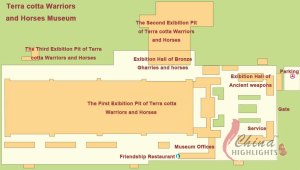For anyone who can read Chinese (simplified), or who wants to practice their Chinese, HERE is an interesting article from www.popyard.org, a popular Chinese news website that discusses whether or not the Tomb of Qinshihuang should be excavated.
The famous mausoleum of Qinshihuang, the first emperor of the Qin Dynasty (221 B.C. – 206 B.C.), has reentered the news recently because of the 3rd excavation on the terracotta warriors pits that commenced earlier this month.
The mausoleum of the famed emperor himself has not yet been excavated, however, due to several competing arguments for and against it. First off, as the popyard opinion piece fervently opens with, “excavating the tomb of an ancient emperor for the sake of boosting curiosity and tourism is (should be) absolutely forbidden;” many Chinese feel that excavating this tomb would be akin to sacrilege, and that the tombs of the ancients, especially an ancient as well-known, respected, and somewhat feared as Qinshihuang should be left in peace and admired from afar. Second, even those who advocate for excavating the tomb are hesitant because they fear the corrosive effects of exposing whatever treasures the tomb may have to offer to the air, which has already been demonstrated on the paint once covering the terracotta warriors.
In addition, there are many myths and stories surrounding what may be contained inside that enormous mound that makes up the tomb, including poisoned arrows, rivers of mercury, and a plethora of guardian spirits. All of these stem from the well-known idea that Qinshihuang, during his lifetime, was obsessed with immortality, and took endless pains to ensure that his body and spirit would be preserved long after his death. If the grandiosity of the terracotta warrior pits so far found are any indication of how seriously Qinshihuang might have been about wanting his mortal remains to be protected, the sheer size of his mausoleum has been an effective deterrant for even the most curious Chinese scholar.
On a more practical level, the amount of tourism that the site has garnered in the last several decades has required the Chinese to ensure its protection. As a result this tomb is one of rare exceptions in China that has NOT been looted to within an inch of its life.
The question now is, what benefit would excavating the tomb bring not only to China, but also to the international community? Is the mausoleum better off untouched? Given all of the arguments against excavating it, dangers contained within, issues of conservation and preservation, and the dangers from without (looting), it is hard to imagine that any information about Qinshihuang and his time period that the tomb could tell us would be worth losing such a treasure. Even hard-nosed archaeologists and people who are pro-information gathering, sometimes have a difficult time speaking up against the tide that upholds the importance of keeping THIS tomb intact.
What are your thoughts on the matter?



